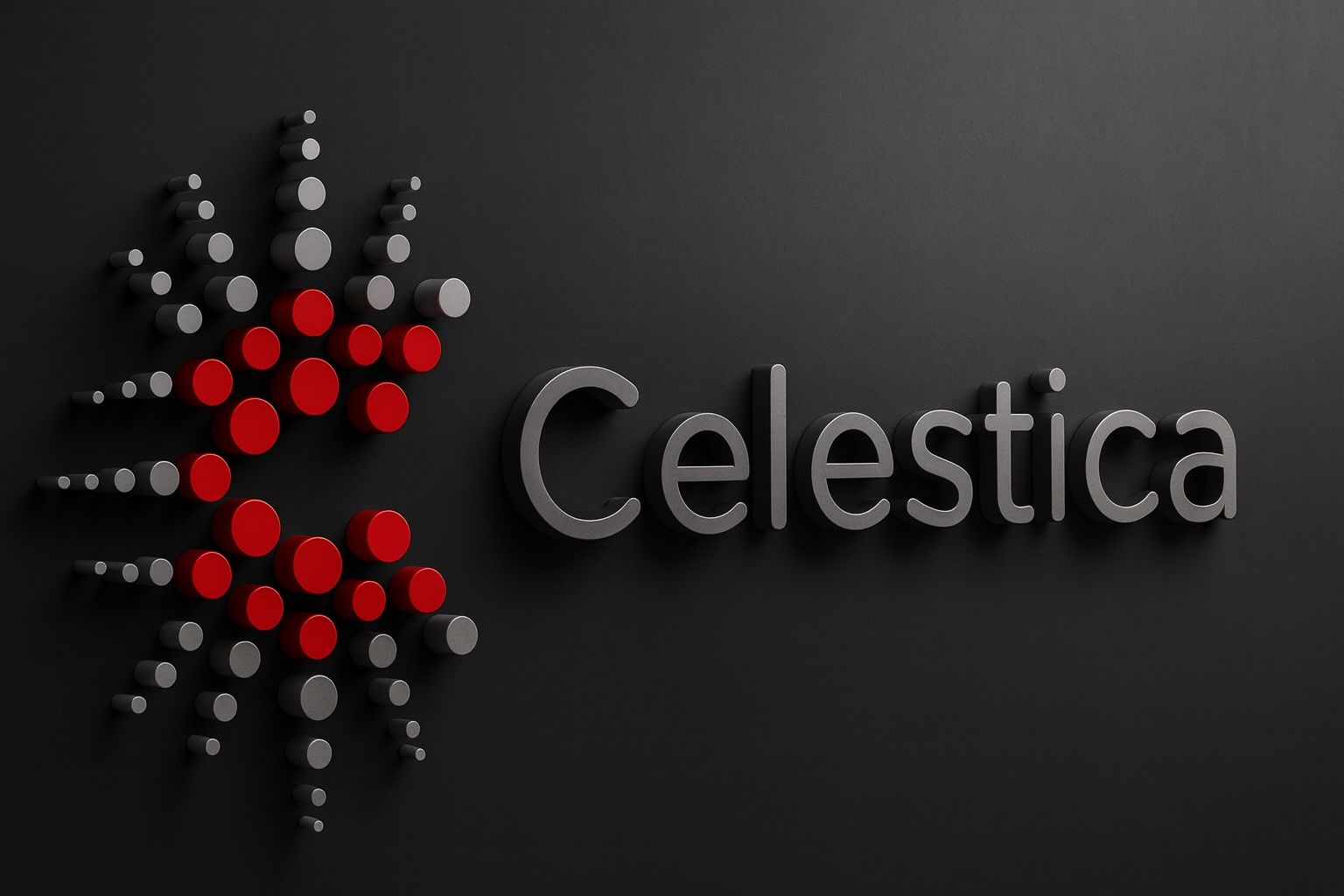- Record surge: Celestica Inc. (NYSE: CLS) stock hit an all-time high around C$460 per share (≈US$340) on October 28, 2025 after jumping about 9% in Toronto trading [1]. The electronics manufacturer’s shares have climbed over 300% in the past year amid a frenzied AI-driven rally [2].
- Blowout earnings: The company smashed Q3 2025 expectations, with revenue up 28% year-over-year to $3.19 billion and adjusted EPS up 52% to $1.58 [3]. Both figures beat the high end of Celestica’s own guidance, prompting management to raise its full-year 2025 forecast to $12.2 billion in revenue and $5.90 EPS (up from $11.55 B and $5.50) [4].
- AI momentum: Celestica is riding surging demand for AI and cloud infrastructure hardware. It introduced new 1.6-terabit Ethernet switches this month for AI/ML data centers [5], and now projects 2026 revenue to leap ~31% to $16 billion as its “largest customers” continue heavy AI data center investments [6].
- Analysts bullish: Wall Street remains upbeat on Celestica’s prospects. RBC Capital recently lifted its target price to $225, citing “robust demand from hyperscalers” [7], and Stifel raised its target to $230 on “growth driven by AI demand” [8]. One analyst even set a C$428 target (roughly Celestica’s current level) alongside a Buy rating [9].
- Reinvented tech veteran: A former low-profile contract manufacturer, Celestica has transformed into an AI-era growth story. The 31-year-old Toronto firm has “shot from near obscurity to stock stardom on the AI juggernaut” [10] as a key supplier of data center hardware for today’s tech giants, shaking off its dot-com era legacy.
CLS Stock Rallies on AI Wave
Celestica’s stock is on fire, extending an extraordinary run as investors bet on the AI hardware boom. On Tuesday, October 28, Celestica shares surged to record highs following its earnings news, reaching approximately C$462 in early trading (a ~9% jump) [11]. This added to a multi-session upswing – the stock gained about 13% in the past week alone [12] – and marked a staggering ~316% increase from a year ago [13]. Such a historic rally has vastly outpaced the broader market and reflects surging optimism that Celestica will be a big winner in the rush to build out AI data centers and cloud infrastructure [14]. Notably, Celestica’s leap helped propel Canada’s TSX tech sector higher on Tuesday, even as broader markets awaited central bank decisions [15].
Once known mainly as a contract electronics maker for other brands, Celestica has reinvented itself for the AI age. The company – founded in the 1990s as an IBM spin-off – spent years languishing after the dot-com bust. Now it’s riding a new wave of demand. As the Financial Post noted, the “31-year veteran of Canada’s tech scene” suddenly “shot from near obscurity to stock stardom on the AI juggernaut” [16]. In other words, Celestica has gone from a forgotten name to one of this year’s stock market darlings by pivoting aggressively into high-growth technology segments tied to artificial intelligence.
Blowout Q3 Earnings and Raised Outlook
Celestica’s latest financial results underscore why the stock is soaring. After markets closed on Oct. 27, the company announced third-quarter 2025 earnings that blew past expectations [17]. Revenue for Q3 jumped to $3.19 billion – a 28% increase year-over-year – while adjusted net profit hit $1.58 per share, up 52% from a year ago [18]. Both metrics exceeded the high end of management’s guidance range [19], making it one of Celestica’s strongest quarters ever. “We achieved very strong results in the third quarter, with revenue of $3.19 billion and non-GAAP adjusted EPS of $1.58, representing growth of 28% and 52%, respectively, each exceeding the high end of our guidance,” said CEO Rob Mionis in the earnings release [20]. The company also delivered record-high profit margins, reflecting improved efficiency alongside booming demand.
Buoyed by these results, Celestica sharply raised its full-year 2025 outlook. Management now expects $12.2 billion in revenue and $5.90 in adjusted EPS for 2025 [21] – up from prior forecasts of $11.55 B and $5.50. This improved guidance implies roughly 34% year-over-year sales growth and highlights accelerating momentum. Looking further ahead, Celestica issued an unusually bullish early peek at 2026: it is projecting $16.0 billion in revenue with about $8.20 in EPS next year (around 31% top-line growth in 2026) [22]. Management’s confidence stems from an order pipeline that shows no sign of slowing. Demand “remains strong” from Celestica’s largest customers, who are “making significant investments in AI data center infrastructure,” Mionis noted – trends the company believes will carry through 2026 and even into 2027 [23].
As a further vote of confidence, Celestica announced plans to launch a new share buyback program, aiming to repurchase up to 5% of its public float over the next year [24]. This move suggests the company sees its shares as undervalued even after their massive run-up, and it gives management flexibility to return capital to shareholders.
AI Hardware Demand Fuels Growth
Celestica’s transformation is being driven by the booming demand for AI and cloud-computing hardware. The company has positioned itself as a key supplier of the physical building blocks for artificial intelligence – the servers, circuit boards, and high-speed networking gear that power modern data centers. In Q3, Celestica’s Connectivity & Cloud Solutions division (which includes data center infrastructure products) saw revenue leap 43% year-over-year to $2.41 billion, far outshining its legacy segments [25]. Notably, sales of Celestica’s custom hardware platform solutions – such as advanced server racks for hyperscale clients – surged 79% in the quarter [26], reflecting huge orders for AI server systems and networking equipment. According to the company, its largest customers (major cloud and tech firms) are making “significant investments in AI data center infrastructure,” directly translating into Celestica’s record sales [27].
“Celestica indicated it is seeing strong demand from its largest customers for AI data center infrastructure and it anticipates strong demand momentum to continue into 2027,” observed RBC Capital analyst Paul Treiber, commenting on the firm’s outlook [28]. In other words, what began as a rush of orders in 2024 has evolved into a multi-year upgrade cycle for AI hardware – and Celestica is reaping the benefits.
To capitalize on the trend, Celestica has been rolling out new high-performance products tailored for AI applications. Earlier this month (October 2025), it unveiled a new family of 1.6-terabit Ethernet data center switches designed specifically for AI and machine learning clusters [29]. These cutting-edge switches (branded the DS6000 series) double the capacity of Celestica’s previous 800G models, enabling far greater data throughput to handle the massive datasets and bandwidth needs of AI supercomputers [30]. The launch, timed to coincide with the OCP Global Summit (a major cloud infrastructure event), sent a signal that Celestica intends to be a leading provider of the “plumbing” for AI data centers. “The introduction of our new 1.6T switches marks a significant milestone… designed specifically to meet the demands of AI/ML clusters,” said a Celestica senior vice president in announcing the product [31]. Industry watchers lauded the move as well – one analyst noted that “Celestica has already proven [its] ability to meet the incredible demand of AI infrastructure”, citing the firm’s track record and recent awards in high-speed networking [32].
Investor reaction to Celestica’s AI pivot has been overwhelmingly positive. Even before the latest earnings, Celestica’s stock was hovering near 52-week highs after the switch announcement, reflecting “strong investor confidence in its AI-focused initiatives,” according to Investing.com [33]. In essence, the market is rewarding Celestica for successfully evolving from a low-margin contractor into a critical enabler of the AI revolution. The company’s market capitalization now tops C$45 billion, and its year-to-date stock return was already above 180% even prior to the Q3 report [34] – a clear sign that investors believe Celestica’s growth story has plenty of runway.
Analysts See Upside Amid AI Boom
Many analysts on Wall Street have raised their outlook for Celestica in light of its rapid ascent and robust earnings. In recent weeks, a flurry of price target upgrades and bullish commentaries have underscored the optimism around the stock. For example, Goldman Sachs initiated coverage of CLS with a “Buy” rating and a $340 price target, arguing that Celestica is a prime beneficiary of the multi-year build-out of AI data centers [35]. Goldman’s team projects Celestica’s annual revenue will soar from about $9.6 billion in 2024 to $21.4 billion by 2029 (a 17% compound growth rate), with earnings growing even faster at 25% per year [36]. In their view, Celestica’s fundamentals are catching up to its stock price – the recent 150% year-to-date surge is justified by the company’s growth prospects and execution, as its valuation begins to resemble other high-growth tech hardware peers [37].
Other analysts echo this optimism. BMO Capital Markets bumped its target up to $300 after the Q3 results, citing Celestica’s strategic partnership with Broadcom and potential wins supplying OpenAI’s future data centers [38]. CIBC recently hiked its target to $315, and Aletheia Capital issued a street-high $350 target highlighting Celestica’s role as a “key manufacturing partner” for Google’s cloud hardware and other new AI projects [39]. Even before earnings, RBC Capital Markets had raised its target to $225 on expectations of “robust demand from hyperscalers” [40], and Stifel upped its target to $230 noting Celestica’s AI-driven growth trajectory [41]. (Those now look conservative given the stock’s latest jump.) According to a Finimize report, 12 analysts currently rate Celestica a “Buy” or “Strong Buy,” with scant signs of bearish sentiment [42] supporting the stock’s momentum.
To be sure, not everyone is unabashedly bullish – a few voices urge caution that the market may be getting ahead of itself. A recent Seeking Alpha analysis titled “Celestica’s Peak? Time for a Pullback” argued that the company’s tremendous AI-fueled earnings gains are now “reflected in its valuation,” implying limited upside unless new catalysts emerge [43] [44]. Thus far, however, the bullish camp has dominated the narrative, and Celestica’s ability to consistently beat forecasts has given analysts plenty of reason to keep raising estimates.
Flex, Jabil, and the Competitive Landscape
Celestica’s stunning stock surge naturally invites comparisons to its peers in the electronics manufacturing services (EMS) industry – particularly Jabil and Flex Ltd., which operate similar contract manufacturing businesses. Over the last 12 months, Celestica shares have skyrocketed ~330%, vastly outperforming Jabil’s ~69% rise and Flex’s ~37% gain in the same period [45]. This divergence highlights how Celestica’s unique exposure to the AI hardware boom has set it apart. While Celestica is now projecting double-digit percentage revenue growth in 2025, some rivals are struggling with softer outlooks: Jabil’s sales are actually forecast to decline next year amid sluggish electronics demand and tariff challenges [46], and Flex is only targeting about 0.4% revenue growth in its upcoming fiscal year [47] – a far cry from Celestica’s ~13%+ growth outlook for 2025.
That said, competitors are racing to catch up in high-growth niches. Flex recently reported that its cloud and data center power solutions segment expanded 50% year-over-year in fiscal 2025, and it anticipates continued strong growth in that area as AI-related demand for power and cooling equipment remains robust [48]. This suggests the AI infrastructure boom is lifting multiple boats in the EMS sector, not just Celestica. Other contract manufacturers like Sanmina have also noted strength in their computing divisions – Sanmina even won a new AI server assembly deal with a chipmaker – and its stock has jumped ~60% this year [49]. Impressive as that is, it still pales next to Celestica’s 200%+ year-to-date leap. Meanwhile, industry giants Foxconn (Hon Hai) and Pegatron are vying for hyperscale server orders as well, though those Asian firms are less transparent (not being U.S.-traded) and thus harder to compare directly [50].
In the broader AI hardware ecosystem, Celestica’s rise is sometimes measured against specialized data center technology vendors. For instance, Arista Networks (ANET) – a leading supplier of networking switches used in AI clusters – has seen its stock climb on the same AI wave. Arista is a much larger company (around $190 billion market cap), but interestingly, Celestica’s rapid appreciation has pushed its valuation multiples closer to Arista’s. Celestica now trades around 40× forward earnings, approaching Arista’s ~44×, as both are priced as high-growth “picks-and-shovels” plays in the AI gold rush [51]. Another parallel is Super Micro Computer (SMCI), a server manufacturer that skyrocketed earlier on AI server demand. SMCI’s shares have been volatile recently, and Celestica’s 2025 stock gain has now eclipsed SMCI’s. In fact, Celestica’s year-to-date rise has even surpassed NVIDIA’s surge in 2025 [52] – a remarkable feat considering Nvidia is the poster child of the AI boom. This underlines how investors have been scouring for “hidden” beneficiaries of AI capital spending beyond the obvious chipmakers [53], and they found one in Celestica.
The bottom line is that Celestica has differentiated itself from the average EMS contractor by diving into higher-value, higher-margin products for AI and cloud. Its gross margin has ticked above 11% (versus ~9% at Jabil) [54], hinting at the richer mix of complex hardware it now provides. Still, competition looms: industry heavyweights like Foxconn or even Flex have the resources to aggressively pursue the same AI manufacturing deals, and if the AI spending cycle slows, all these suppliers could feel a pinch. For now, Celestica enjoys a bit of scarcity value as one of the purest publicly-traded plays on AI infrastructure growth in North America [55], which helps explain its premium valuation.
High Hopes vs. High Valuation – What’s Next?
With Celestica’s stock up so sharply, the natural question is: what comes next? Expert opinions diverge between bullish believers and cautious skeptics, largely depending on how sustainable the AI hardware boom proves to be and whether Celestica’s valuation is justified at these levels.
Bullish case: Optimists contend that Celestica is at the forefront of a multi-year secular growth cycle. The company’s own guidance and customer order patterns suggest AI-driven demand will remain strong through 2026 and beyond [56] as cloud giants roll out successive generations of AI servers and networking gear. Goldman Sachs, for one, forecasts that Celestica’s annual revenue will more than double over the next five years (reaching ~$21 billion by 2029) and that earnings will grow at a 25% annual clip [57]. If Celestica hits its $8.20 EPS target in 2026, even the recent ~$300 share price would equate to a forward price/earnings ratio of ~37× – not unreasonable for the kind of growth and market positioning the company could have [58]. Bulls also point to the wave of analyst upgrades and expanding partnerships: Celestica’s close collaboration with Broadcom on cutting-edge networking hardware and its rumored involvement in OpenAI’s upcoming supercomputing plans are seen as signs of an expanding opportunity set [59]. In short, the bullish thesis is that Celestica’s execution will continue to surprise to the upside, allowing it to eventually “grow into” its rich valuation as earnings catch up. Some have even called CLS a top pick to play the “AI arms race” in data centers [60].
Bearish case: On the other hand, skeptics caution that a lot of good news is already priced in. After a 300%+ share price run-up in one year [61], Celestica’s valuation looks full by many traditional metrics. The stock is now trading around 58× trailing earnings and over 20× forward EBITDA, which is quite lofty for what is still fundamentally a manufacturing business with mid-single-digit net margins [62]. While such multiples might be comparable to high-flying tech hardware peers, they are much higher than those of classic EMS rivals like Jabil or Flex (which trade at P/E ratios in the mid-teens) [63]. Any stumble in Celestica’s execution – or even a slight moderation in its growth rate – could trigger a sharp correction from these heights. The recent Seeking Alpha analysis noted that the stock’s tremendous AI-fueled EPS gains are now “reflected in its valuation,” implying limited upside unless new catalysts emerge [64]. Bears also remind investors that the electronics supply chain is cyclical and fickle. If cloud providers (the hyperscalers) pause their spending or shift some manufacturing in-house, Celestica’s order flow could ebb. Additionally, competition is intensifying – for instance, if a player like Foxconn decides to aggressively undercut pricing to win AI server assembly contracts, it could pressure profit margins industry-wide [65]. Given Celestica’s need to continue investing heavily in R&D and capacity to meet demand, any slowdown could expose it to margin compression. In sum, the bearish view is that Celestica’s stock may have run too far, too fast, and that any hint of an AI spending slowdown or an earnings miss could spark a significant pullback from current levels.
For its part, Celestica’s management appears aware of both the huge opportunity and the execution challenges ahead. The company is hosting a 2025 Investor Day in New York on Oct. 28, where leaders are expected to detail their strategy for scaling up to meet demand [66]. Key topics likely include how Celestica will add manufacturing capacity and manage supply chain constraints (a critical issue when ramping up complex hardware production) while maintaining its recent performance [67]. Investors will also watch for any new partnership announcements or customer wins that could unlock further growth.
Meanwhile, macroeconomic factors lurk in the background. Celestica’s surge has come despite a higher interest rate environment and periodic market volatility. Going forward, a stable economy and continued capital spending by tech giants will be important to support Celestica’s lofty 2026 targets. Any signs of hesitation in AI infrastructure investment could test the stock’s resilience, whereas confirmation of continued “blowout” results or big new contracts (for example, a rumored OpenAI data center deal) would validate the bulls and could propel the stock even higher.
For now, Celestica’s story serves as a striking example of a legacy manufacturing company reinventing itself in the age of AI – and being rewarded handsomely by the market. The stock’s dizzying climb in 2025 reflects investors’ voracious appetite for AI exposure, even via less obvious picks-and-shovels players. Whether those gains keep accelerating or finally take a breather may depend on how the next chapter of the AI boom unfolds. But as of late October 2025, Celestica has the market’s full attention – emerging as one of this year’s standout winners at the intersection of technology and manufacturing. Sources: TS2 Tech [68] [69], Reuters [70] [71], Investing.com [72] [73], GlobeNewswire/Celestica release [74] [75], TS2 Tech (competitor analysis) [76] [77].
References
1. www.marketscreener.com, 2. ts2.tech, 3. ts2.tech, 4. ts2.tech, 5. ts2.tech, 6. ts2.tech, 7. ts2.tech, 8. ts2.tech, 9. ts2.tech, 10. ts2.tech, 11. www.marketscreener.com, 12. ts2.tech, 13. ts2.tech, 14. ts2.tech, 15. www.marketscreener.com, 16. ts2.tech, 17. ts2.tech, 18. ts2.tech, 19. ts2.tech, 20. ts2.tech, 21. ts2.tech, 22. ts2.tech, 23. ts2.tech, 24. www.investing.com, 25. ts2.tech, 26. ts2.tech, 27. ts2.tech, 28. www.investing.com, 29. ts2.tech, 30. ts2.tech, 31. ts2.tech, 32. ts2.tech, 33. ts2.tech, 34. ts2.tech, 35. ts2.tech, 36. ts2.tech, 37. ts2.tech, 38. ts2.tech, 39. ts2.tech, 40. ts2.tech, 41. ts2.tech, 42. finimize.com, 43. ts2.tech, 44. ts2.tech, 45. ts2.tech, 46. ts2.tech, 47. ts2.tech, 48. ts2.tech, 49. ts2.tech, 50. ts2.tech, 51. ts2.tech, 52. ts2.tech, 53. ts2.tech, 54. ts2.tech, 55. ts2.tech, 56. ts2.tech, 57. ts2.tech, 58. ts2.tech, 59. ts2.tech, 60. ts2.tech, 61. ts2.tech, 62. ts2.tech, 63. ts2.tech, 64. ts2.tech, 65. ts2.tech, 66. ts2.tech, 67. ts2.tech, 68. ts2.tech, 69. ts2.tech, 70. www.marketscreener.com, 71. www.marketscreener.com, 72. www.investing.com, 73. www.investing.com, 74. ts2.tech, 75. ts2.tech, 76. ts2.tech, 77. ts2.tech







